#african tradition religion
Text

Bakongo spiritual protections influenced African American yard decorations. In Central Africa, Bantu-Kongo people decorated their yards and entrances to doorways with baskets and broken shiny items to protect from evil spirits and thieves.
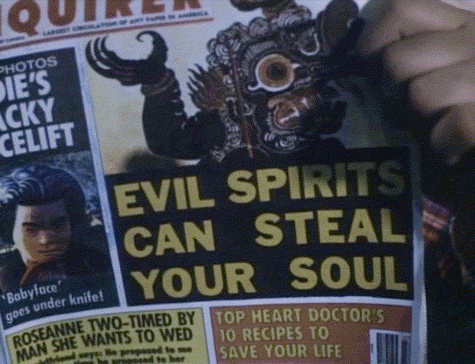
This practice is the origin of the bottle tree in Hoodoo. Throughout the American South in African American neighborhoods, there are some houses that have bottle trees and baskets placed at entrances to doorways for spiritual protection against conjure and evil spirits.
In addition, nkisi culture influenced jar container magic. An African American man in North Carolina buried a jar under the steps with water and string in it for protection. If someone conjured him the string would turn into a snake. The man interviewed called it inkabera

#inkabera#nkisi#hoodoo#african american#african traditional religions#kongo#bantu#central africa#north carolina#bottles#african#afrakan#kemetic dreams#africans#brownskin#afrakans#african culture#afrakan spirituality#glass#dishware#wood#glassware#hearts
168 notes
·
View notes
Text
Tag yourself!
{made with the Ancestors and Great Spirits of the African Diaspora in mind, here's what I associate with each day of the week and the children of the diaspora born therein:
Monday's child is fair of face
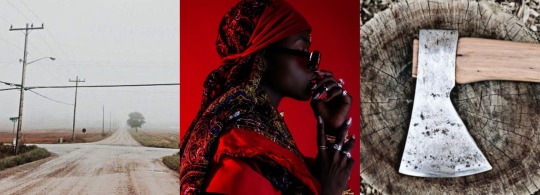
Tuesday's child is full of grace
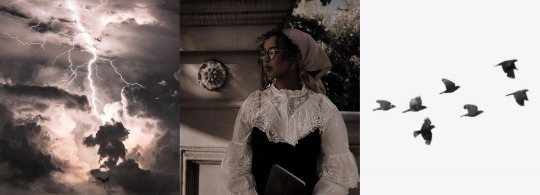
Wednesday's child is full of woe
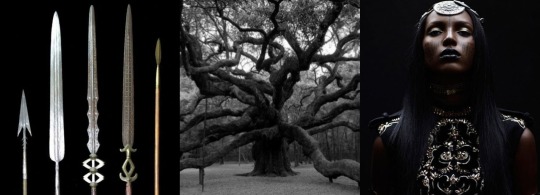
Thursday's child has far to go

Friday's child is loving and giving
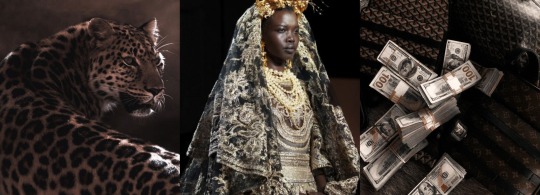
Saturday's child works hard for a living

And the child born on the Sabbath day
Is bonny and blithe, good and gay.
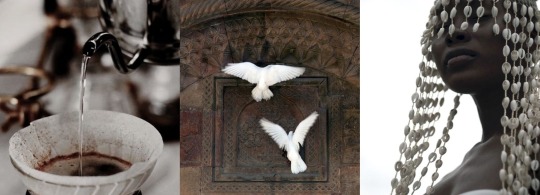
Monday: masters of finding new roads and moving forwards, tearing down blockages, trailblazers and warriors. Artists of all kinds, writers, poets, singers.
Tuesday: embodiment of thunderstorms, winds, omens, they're powerful conjurers with hot hands, always busy, always moving. Often times scholars, historians.
Wednesday: defenders, protectors, of humanity and nature as a whole. Warrior spirits at their core, but also great diviners and mediums.
Thursday: eloquent muses of the arts of love and war alike, great beauties who lead armies with equal charm and force. Sweetening, love and luck workings come easy to them.
Friday: personification of abundance and status. A commanding presence. Building legacy, great manifestors and conjurers, specially for work and finances.
Saturday: guardians of waters and the beyond. Community leaders, gifted healers, divine messengers. Carrying all the wisdom of the Elders and Ancestors.
Sunday: priests and priestesses that defy status quo, very old Ancestors coming back to reshape and rebirth reality. They will enter your life and purge every aspect of it.}
#Hoodoo#Rootwork#Conjure#Black Conjure#African american conjure#Hoodoo aesthetic#Hoodoo academia#I've had this in my drafts for so long!!!#enjoy :')#ATRs#ADRs#African Traditional Religions#African Diasporic Traditions#African Diasporic Religions#African Diaspora#afrolatine#afrolatinos
351 notes
·
View notes
Text
Witchcraft Supplies & Occult Publishers
A growing list of resources for Magic.
It is imprtant that we support our occult shops and publishers. but also all relevant supplies are helpful as well.
#witchcraft#occultism#sorcery#folkmagick#occultbooks#paganism#Pre-christian religions#african traditional religions#afro caribbean traditional religions
62 notes
·
View notes
Text

Spelman’s first graduating class of 1887 during the Gilded Age.
Vintage Black Glamour & History ✨
#hoodoo#black femininity#aphrodite#the love witch#venus#haitianvodou#black glamour#leveling up#hypergamy#beauty spells#erzuliefreda#african traditional religions#pagan community#witches of color#witchblr#oshun#vintage black glamour#vintage glamour#victorian age#the gilded age#spelman#black owned business#witchcraft#black women in luxury
532 notes
·
View notes
Text
The Hoodoo That You Do
Hoodoo first and foremost is a closed practice.
Within a western audience, the concept of a closed practice can be rather challenging for many, as it runs entirely contrary to the notions we are brought up believing surrounding religion in the West.
Socio-culturally, religion in the West has evolved under the mantle of Christendom. This evangelizing religion characterized by its soteriology(savior ideology) , ease of access, and proselytizing habits is open to all, radically so. All you need is to accept Christ as your personal Lord and Savior, and live righteously according to the Bible to secure eternal salvation. In many respects, Christianity uniquely conquers the mystery religions of old, characterized by their distinctive intimacy with the divine, secrecy and ritual, and subverts it, by making it universally open to all and actively telling you about it.
This line of thinking regarding "closed practices" can also be difficult with many western minds that have had extensive influence from movements such as the “New Age” movement, which seeks to bring together unrelated material spiritual identities under one umbrella.
Many people in the “New Age” movement have been largely influenced by the writings of the Theosophical society, which were some of the first writings on Dharmic religions available to a broad audience in accessible languages in western countries. This means that many of these individuals ideologically do not believe in the idea of culture since they eschew the cover of self, many believe we reincarnate across familial lines, species and even galaxies, fall prey to solipsism and claim that they themselves are the only real thing that exists, therefore everything is open to them, or purport an intrinsic universal connection through the Jungian collective consciousness that makes all things open to them. Having a unique gnosis dependent on your religious affiliation is normal and expected, using it to harm others is not.
Similarly, Christianity undermines the concept of ethnic religions and cultural religions which are predicated upon being born into them, or having immediate access into certain respective belief systems for validity in practicing them. Finding Divinity in the Christian tradition has nothing to do with where you were born, who you are or how you were brought up, but rather, is entirely up to ideology, practice, and a consistent theme of universalism.
However, as stated prior, due to ethnic and cultural religions being experiential, they are much more tied to a way of life, being, and a contextual identity in order to operate within the cosmological framework. This can be ancestral; do you descend from the founders of the tradition, are you connected by blood in some significant way in recent history? Land-based, i.e venerating a particular river, mountain, cave etc. And lastly, communal, do you speak the liturgical language of the religion, do you eat the same foods, do you understand the offerings? Many ADRs fall into the aforementioned pattern above. Many Hougans and Manbos will tell you that there are Lwa(Intercessory divinities in Vodou/Voodoo) that can only be summoned on Ayiti, making it a uniquely land based practice, and while in Santería, Boromú, an Orisha associated with the desert,and dryness, all but disappeared in lush and tropical Cuba. Most, if not all religions do start as ethno-religions, and many of them still have vestiges of these ideas present within them, and despite the open and universal evangelism of Christianity, even its spiritual practices fall into some of the land specific beliefs and functions mentioned previously.
It is in this contextualization of land, self and identity, that we begin to understand Hoodoo as not merely a “folk magic” practice, but a Magico-Religious tradition uniquely conjoined with the cosmological spiritual experience of Soulaani people in the United States. Hoodoo, like many American ADRs, is plantation religion, and as with the mentioned ADRs above, Vodou and Santería respectively,is syncretist in nature and a highly Africanized interpretation of the Christian faith which was violently enforced upon the enslaved.
Hoodoo historically is a belief system that was foundationally built as a form of resistance to European oppression, violence and abuse. With an emphasis on ancestor veneration, figures such as Nat Turner, Harriet Tubman and Frederick Douglass are heralded as elevated community ancestors, whilst figures such as High John The Conqueror, a mythic African king who could outfox any Slaver or false master, is deigned a powerful, worthy, and venerable Spirit.
The cosmology of Hoodoo, while being deeply Christian, is Animistic in nature and boasts a large host of Land and Place spirits with whole identities and person-hoods. Some of these spirits are “Elevated Ancestors” similar to the saints of Orthodox and Catholic traditions, while some of them are entirely natural in origin such as Simbii or Samunga.
Hoodoo, similarly to the American south from which it originates, exists equally in a Protestant and Catholic context, and also incorporates Native American wisdom and land knowledge into its Theological foundation because of Indigenous admixtures in Black populations, and vice versa, as can be seen by the Florida Seminole tribe with it's high afro-indigenous population to this day and many more.
With its context, it is no wonder that people feel that Hoodoo is an open practice, by its very origin, it is an act of black labor, meaning, it's meant to be exploited. All black labor, be it intellectual, physical, emotional or in this case, spiritual, is an open and free resource that can be cheerfully parasitized from by a broader audience, without acknowledging its history, origins or foundations. This unfortunate reality extends even beyond the Black American experience and universally unites the Black diaspora in imperialist or colonial states worldwide. When researching the origins of certain foods, dances, customs and ideas, it will be difficult to find the genuine full hearted acknowledgement of the enslaved and their contribution to broader knowledge and culture, this is the case in Latin America as well in both material and spiritual culture.
The colonial state chooses what is “Everyones” or rather, “American” and what is “Black” at any given time, and can choose to revoke and review these designations at will. A particularly clear example is Jazz music.
What once started as the herald of reefer madness, debaucherous devil music and depravity, has become the backdrop of urban luxury, sophistication and wealth. This is of course after the domestication of jazz at the hands of predominantly white musicians, who made it more palatable to the broader audience and it's popularization among the rich and famous.
Another example is soul food. What many consider to be “southern cuisine” is uniquely Soulaani in origin, however, due to the overall positive reception, accessibility and good reputation of soul food it became subsumed into the greater American identity not as a black invention, but an American one.
Similarly, Hoodoo received much of the same treatment in the late 80s- 90s. Instead of the lowbrow superstitions of slaves, Hoodoo was rebranded as a distinctly American “hodgepodge” practice, meant to appeal to aesthetics surrounding pastoralism,the rustic rough and ready, and a peculiar edginess, ethnic enough to bite but close enough to home not to leave a scar, after all, Hoodoo was never African according to Ross, and Hoodoo “Authorities” such as Yronwood “The earliest usage of the word “hoodoo” is connected with Irish and Scottish sailors, not African slaves, and may be a phonetic pronunciation of the Gaelic Uath Dubh (pronounced hooh dooh) which means evil entity or spiky ghost. In the mid 19th century, cursed, abandoned “ghost ships'' were called hoodoo ships or were said to have been hoodooed.”(2021,Ross).
The ability for the colonial machine of the U.S to change and claim things from being one thing, and subsume it into a greater American identity without any of its former history, or identity, is one of the things that makes colonial nations so distinctly villainous in the continued exploitation of marginalized identities. Such as Britain's National dish being Chicken Tikka Masala without even acknowledging the incredibly dark history of the East India Company and its dark impact on the whole of the Indian subcontinent. This consumption of identity is the reason why the black American appears to be “without culture”, and why Black Americans themselves can occasionally feel bereft of a unique identity. Often noted by others across the Black diaspora, Black Americans are often the butt end of everyone's jokes from the Caribbean, Latin America and Africa itself. This “stateless” identity sometimes displayed by Black Americans is by design by the colonial state, and a symptom of religious displacement and spiritual abuse at the hands of said colonial powers.
This powerful and calculated form of psychological warfare and its effects can be seen in the likes of Hebrew Israelites who claim to be the original Jewish diaspora, Kemetics who claim to be the original Egyptians and those who claim to be the original Native Americans. This speaks to a desperate longing to belong to something that goes back centuries, that is ancient, and worthy and powerful, none of them wanting to claim the legacy of slavery and its ramifications. With many Black Americans struggling to accept the lived history of chattel slavery, who will proudly embrace this “plantation religion”?
With these contributing factors, Hoodoo can come across as being either a failed attempt at reconnection conceived in the minds of desperate African Americans, a made up ahistoricism (as is often asserted in the case of Voodoo in Louisiana) or a genuinely all American folk practice open to all with no authority, order, or true history.
In fact, referencing a broader global view of African Americans, their customs, practices and identity,a global audience inverts the name into American Africans. A culture and identity that is a product of the eurocentricity and whiteness around it. America appears to be the land of “The Whites” and a “Second Europe” in public perception. However, many of these narratives come from individuals who have either; A. Never set foot in America or B. Decided that they would base all their perceptions off of an experience they had on a trip they took to Greeley Colorado in 2009, and movies. Neither of these are accurate as the American identity is not homogenous.
Hoodoo, while originating in the American South, is a land-based spiritual practice. Subsequently, it has evolved tremendously as it made its way Westward and North among the black diaspora itself. All spiritual practices, particularly land based practices, are beholden to regionalism. Regionalism is the antithesis of homogeneity. It is reflexive to categorize the gamut of all things with “American” origins as one homogenous mass, but this is both intellectually and materially disingenuous. All ADRs are regionalist, and this alone creates a dramatic difference in said practices.
Take for instance the various emanations of Palo, with four major denominations, Monte, Kimbisa, Briyumba and Mayombe. These four distinct Theological traditions evolved separately, largely in part because of geographical differences and different leadership. These seemingly subtle differences evolved overtime into hallmarks of an identity in how each sect handles spirits, the spirits they venerate, language(s) used, and major beliefs pertaining to cosmology and world structure. Notice however that all of these originated on the Island of Cuba. Cuba is roughly 750 miles long and 60 miles wide, driving from Denver Colorado to Billings Montana is 693 miles and takes around 10 hours to drive, while it typically takes only one hour to drive around 60 miles. The variety of spiritual beliefs in one tradition in a stretch of 750 miles is profound, and this isn't even taking into account the other traditions on the island, so why would we expect it to be different in the United States?
Which leads me to the question, what is the Hoodoo you do? Do you know its region, its history, its spirits? Just as there isn't a generic “Palo” tradition, or a Generic Vodou/Vudú/Voodoo, which also boast a robust number of lineages, most notably Tcha Tcha and Asogwé, there is not a “generic” Hoodoo, and the question becomes less about whether or not it's closed(it is), and more about it's cultural relevancy. The Hoodoo of a third generation New Yorker is going to look wildly different from the Hoodoo we see from a third Generation Californian, and let's add a caveat, the Hoodoo you see from a third generation Californian in the Bay area is going to be different from the Hoodoo from a Los Angeles Hoodoo, because of admixture, geography, and exogenous and endemic cultures in the region. In that same vein of inquiry, do you draw your lineage from the Baptist tradition of Churches, AME, Catholic, African American Spiritual tradition? All of these differences make for a different practice, and different structure.
Among the variations and differences in the Hoodoo tradition of the U.S also comes differing and various cultural attitudes to Hoodoo itself. In the broad Americas(the Caribbean and LATAM Included) the practice of banning and criminalizing Black and Indigenous spiritual practices was incredibly common and could be as dire as even leading to an individuals death “After emancipation, many countries in the Western Hemisphere passed new legislation attempting to suppress the religious practices of the formerly enslaved under the guise of “civilizing” their populations. Countries like Brazil, Jamaica, Cuba, and Haiti enacted laws that prohibited persons from engaging in “superstitious” rituals, fortunetelling, vagrancy, and similar practices. In the United States, African American herbalists and sages (whom the media described as “voodoo doctors”) were also arrested for providing medico-religious and divination services. However, once again, the U.S. government deployed generally applicable laws to suppress these practices; they did not craft new legislation to target the “superstitions” of the formerly enslaved. These individuals were charged with contravening laws against obtaining money by false pretenses, mail fraud, practicing medicine without a license, and related offenses.”(Boaz, 2017). Because of this, black America did their best to disassociate with “superstitions” and “barbaric” customs to avoid further discrimination and being targeted. If you went up to a black elder and asked them what “Hoodoo” was, they'd probably slap you in the gums and call down Holy Ghost fire upon you and yours. It wasn't until 1996 that the American Indian religious freedom act was codified into law after years of indigenous communities enduring the same discrimination as Black ones for alternative spiritual customs and traditions could finally safely practice their own religious and spiritual customs without fear, and these attitudes still linger in both communities respectively.
With all that being said, the question remains. Why must it be Hoodoo that you do? Were you adopted into a family that lovingly shared it with you from the time you were young to now? Did you break bread with these people, do you fight for their liberation with every breath? Do you really think being black in a “past life” grants you access to the trauma you most likely care very little about in this present one?
Magico-religious folk customs are a dime a dozen, many, open! Some closed. Hoodoo however, is contingent upon the social memory of slavery, oppression and a fight for justice. When putting the spirits to work, do you do so with a spectral whip in your hand, and the entitlement to Black bodies and Souls of those who came before you? The joy of learning and spiritual specificity is that you can find a practice you resonate with out of the multitudes that litter the masses of the American continent that may be socio-culturally relevant to you. Such as Italian stregheria which is prominent in some parts of upper Appalachia and New York, Ozark and Appalachian granny magic, Cajun Traiteur, Spanish American Brujería of the Southwest (as in SPAIN),Pennsylvania Dutch Braucherei, there are even Cunning folk practices associated with the Mormon church and Utah. Some of these despite being of European American Origin, are also closed because they are experiential.These are all uniquely American in nature, this is excluding places outside of the U.S who also have a multitude of open mystical practices, such as Ancient Egyptian Heka, or Hellenic Göetia, none of them with the baggage of Indigenous and Black trauma as an aesthetic.
Ultimately, everyone will do what they want and that's just a fact of life, I however hope this helps you stop and think of the damage you do to your Black and Brown siblings whose ancestors died for the right to pray to a God that looked like them when you insist on the right to access to BIPOC labor spiritually,mentally and physically.
#hoodoo#spiritualism#african american spirituality#soulaan#espiritismo#atr#african traditional religions#african diasporic religions#vodou#vudu#voodoo#santería
34 notes
·
View notes
Text
White Women and Conjure
this is a series of q&a's from a bunch of Non Initiatied Non POC Tryin to do something, that they don't understand.
No doubt some will read this and see where it says no initiation required, but thats where its telling you it's all not your culture and yu should stop messing with it - because it's not yours.
Appropriation can be extremely dangerous if you follow a goat to a lion's den, and with this person thats exactly what you're doin.
Stop Appropriating Traditional African Practices and Religions







#Stop Appropriating Traditional African Practices and Religions#appropriation#conjure#hoodoo#ATR#African Traditional Religion is a closed practice#African Traditional Religion#Black Lives Matter#Ancestor Work
22 notes
·
View notes
Text
I’ll be moving in a couple of weeks, and I’m procrastinating on packing by planning out the interior design 😅
The plan is to make something out of black-and-white pictures of my favorite deceased authors to decorate my writing space as sort of an ancestral altar/vision board art piece.
I can’t decide between these two for Toni Morrison because they both give very different vibes that I love equally:
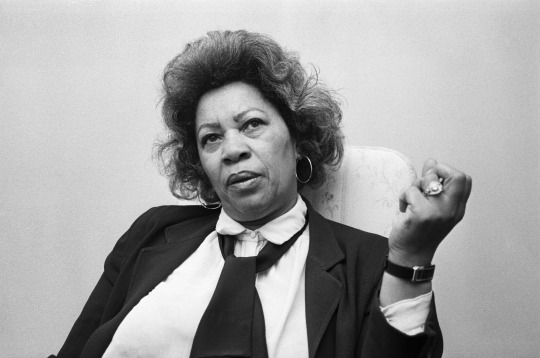

🚨 HELP🚨
#cecewritessometimes#cece’s ramblings#toni morrison#black writers#ancestors#ancestral veneration#ancestor altar#hoodoo#african traditional religions#vision board#work from home#manifesting
22 notes
·
View notes
Text
So the thing with Tems had me thinking a little bit.
More Black people who were raised Christian and left the religion are turning towards Ifá/Santeria/Candomblé or Òriṣà worship in general for many reasons.
Just know that not all Yoruba people are open to that. colonization did it's thing at demonizing that practice to many people. I'm part of the lucky few Yoruba people who's family still respects our heritage and honour the Òriṣà even though most practice Islam or Christianity. My dad side is still a Ṣàngó house, my mum side Ọṣun house.
If you meet a random Yoruba person and start talking about Òriṣà they might call it idol worshipping and rebuke it in the blood of Jesus Christ because they might be Catholic or something. Or they might say there is no God other than Allah because they are Muslim.
As a Yoruba person not even I would assume some respected the traditional religions. I have had arguments with fellow Yorubas and Igbos and other ethnic groups in Nigeria and West Africa while waving around the novel Things Fall Apart
It's just something to keep in mind.
42 notes
·
View notes
Photo

“Egungun,” Sakété, Benin by Stephan Gladieu
#Egungun#egun#eggun#ancestors#Africa#Stephan Gladieu#African Traditional Religion#ATR#African Spirituality#spirituality#Black spirituality#Orisa#Orisha#Benin#Alagba Odje Lazard Adémola#Sakété
160 notes
·
View notes
Text
I feel as if materialism takes away from the purpose of practice. You are trained to believe that with more, you can achieve more. That is not the case. Realize that you can achieve your goals within your practice without spending money. When you understand that, you may be interested in studying more and engaging in meaningful practice.
#witchblr#divination#witchcraft#hoodoo#african american#african traditional religions#tarot#crystals#numerology
14 notes
·
View notes
Text
24 notes
·
View notes
Photo
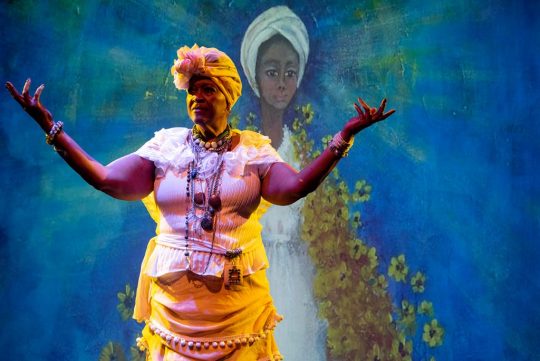

THE IFA CONCEPT OF SOCIOLOGY
Yoruba culture has used the Ifa paradigm of the cosmos as the basis for building their major cities. The structure of the Yoruba Nation was a federation of city states. Each city was ruled by an Oba. In ancient times the Oba was never seen by his subjects, so he became the invisible nucleus of the circle that formed the city. He was surrounded by a female council of elders called Odu and a predominantly male council of elders called Ogboni. The city itself was supported by male and female work parties who tended to divide their labor along gender lines. The men were traditionally farmers and the women traditionally controlled the market place. Both men and women participated in craft guilds that preserved the techniques used in the arts. The cities were built in a circular formation with the compound of the Oba at the center. The symbolic image of Yoruba culture appears as follows:

There is some archeological evidence in the Yoruba cities of Ile Ife and Oyo that suggests that this design was used as the basis for the actual layout of those cities. The extent to which this occurred in other cities has not been thoroughly researched. It does appear that this structure was used in pre-colonial times as the basis for establishing political and religious institutions both of which were built upon the cosmological model found in Ifa.
Variations on this structure involved the system of establishing the location for sacred shrines. The system is called Gede which is a very old form of astrology. In Gede the path of solar bodies and planets is marked in relationship to the ways that they transverse the landscape. Celestial bodies are believed to enhance the ase (inherent power) of natural forces that arise from the Earth. By correlating the influences of Olorun and Ile, the ancient diviners were able to consecrate their shrines in places that reflected the essence of specific Odu.
Earth (ile) was considered a reflection of Heaven (Orun) and the layout of Yoruba cities was designed to make them mirrors of the cosmic order. The religion of Ifa originally comes from the city of Ile Ife. In lfa scripture, Ile Ifa is described as the original home of humans. The words: "Ile Ife” translate to mean; "Spreading Earth." So Ile Ife is a city and it is any place where land formed on Earth that allowed for human evolution to take place. Ifa scripture also refers to Ile Ife as a Spiritual place. It is the home for those ancestors who have returned to Source.

D. THE IFA CONCEPT OF PSYCHOLOGY
Perhaps the most accessible manifestation of Odu is through the portal of individual consciousness. Ifa teaches that Odu represent the energy patterns that create consciousness. They are analogous to what Carl Jung called archetypes of the collective unconscious. Jung believed that there exists a set of primal patterns that form the content of self-perception and place the self in relationship to the world. According to Jung, these patterns remain abstract until the unconscious gives them a cultural and personal context. In both Jungian psychology and the Ifa concept of consciousness, Odu (archetypes) can be revealed through dreams, where they take on personal qualities and manifest as mythic drama. By grasping this particular manifestation of Odu, Ifa teaches that it is possible to create internal balance which is the foundation of living in harmony with Nature.

Ifa psychology is linked to the concept of ori. The literal translation of ori is "head." This is a limited definition because ori also implies consciousness and Ifa cosmology teaches that all Forces in Nature have ori or consciousness.31 Because Ifa believes in reincarnation, every ori forms a polarity with ipori. The ipori is the eternal consciousness that exists in Orun (Heaven).32 It is the ipori that forms the link between past and future lives. If a scripture describes the ipori as the perfect double of ori. According to Ifa cosmology, every ori makes an agreement with Olorun prior to each incarnation.33 This agreement outlines the type of life that is to be lived and the lessons that are to be learned in a given lifetime. At the moment of birth the content of this agreement is lost to conscious thought. Part of the process of establishing internal balance is viewed as the task of remembering the original agreement between ori and Olorun.

This agreement is the source of individual destiny. Because divination is considered a method for discovering destiny, all divination based on Ifa is related to the question of enhancing the alignment between ori and ipori.
The link between ori and ipori lies within ori inu.35 The Yoruba words; "ori inu" translate to mean; "inner head." This is a reference to what Jung called the individual consciousness or self. Ori inu is the nucleus of that circle of Forces that creates self-awareness.
In addition to the polarity between ori and ipori, ori inu is the center point of the polarity between ara and emi. Ara is the physical body. Ifa psychology includes the heart (okan) and the emotions (egbe) as part of the physical self. According to lfa, the nature of one's ipori can only be grasped if the head and the heart are in alignment. In other words, the mind and the emotions must be in agreement if spiritual insight is to occur. Similarly, Jung understood that a conflict between the mind and the emotions is one of the sources of mental illness.36 In Ifa this conflict is called ori ibi. It is difficult to make a literal translation of ori ibi, but the term suggests a lack of alignment between ori and ipori. When the ori and ipori are functioning as one, it creates a condition called ori ire. A literal translation of ori ire would be; "wise head." .Jung referred to this condition as individuation, which was his basis for defining mental health.37
Ara or the physical body exists in polarity with emi. The Yoruba word emi means; "breath.” Ifa teaches that the breath of life comes from Olodumare and contains the eternal essence of consciousness. Emi in this context would translate to mean; "soul." The Ifa symbol of self would appear as follows:


#ifa#vodun#kemetic dreams#traditional african religion#african spirituality#african culture#west africa#odunlade adekola#ori#orunmila#oya
470 notes
·
View notes
Text
I was watching In Our Mother’s Garden (2021) on Netflix last night and was surprised to see Dr. Zauditu-Selassie cook for and feed the ancestors at around the 1 hour mark in what fits Dr. Brenda Marie Osbey’s description of an authentic voodoo tradition. Dr. Zauditu-Selassie explains her family of creole descent was matrilineal and “believed in Hoodoo,” though she is now a priest of Obatala in the Lucumi tradition. I understand many of the African diasporic religions share commonalities, though distinct, such as feeding the ancestors, but this is probably the closest to an authentic and respectful depiction that exists out there.
I’ve linked a list of additional resources on Lousiana Voodoo and Hoodoo here.
14 notes
·
View notes
Text

214 notes
·
View notes
Text
I have something beautiful to share with you all: give this a listen. What do you think it is?
There's many different versions of this song, just type "Misibamba" on spotify or youtube, and enjoy. It's specifically an AfroArgentinean song, with most of the versions of this song recorded in Buenos Aires. According to african scholars, the song was originally in kikongo, possibly from the Benguela Nation, and it's traditionally sung to call on God (Nzambi Npungu). Some of the words have gone through slight (and not so slight) pronunciation or spelling changes but it's still recognizable for scholars in Angola!
What scholars say about it being originally used to call on God fits our own oral tradition and custom too, it's a religious song. Our elders sing it in times of need, when you need that extra ancestral and divine protection or guidance, and Elders say it was originally sung by our Ancestors in the slave ships as they were crossing the atlantic !!!
And it's not even the only song that remains! there's many other songs in african languages and derived dialects, remembered and sung by afroargentine Elders across the country. After so many years of denial and historical whitewashing, I'm so, so deeply grateful for all the afroargentine and african scholars, and afroargentine collectives and associations, working to preserve our music and dialects, and finally bring them back to the light, to remember and honor our Ancestors.
#Afroargentina#Afroargentinean#Afrolatinos#Afrolatines#Afroargentine#Afroargentines#history#afroargentine history#kikongo#angola#benguela#Nzambi Mpungu#ATRs#ADRs#African Traditional Religions#african diaspora#black argentina#black argentines
19 notes
·
View notes
Text
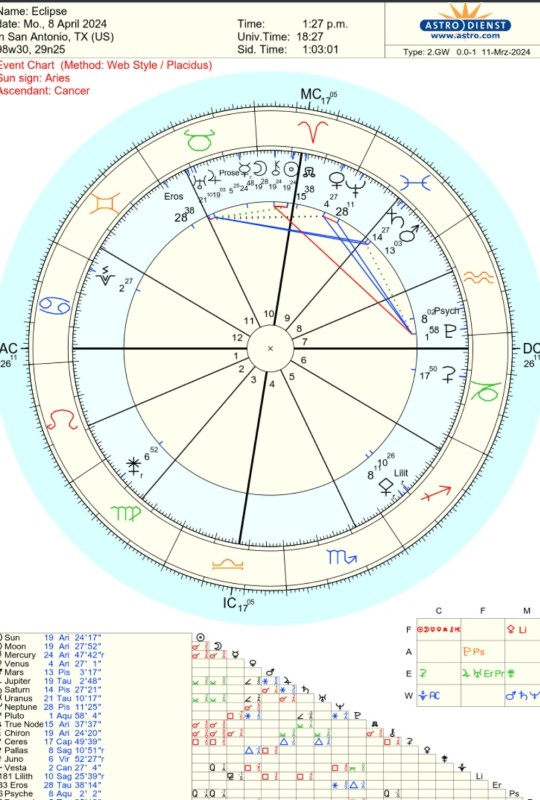
Total Solar Eclipse: April 8th, 2024,
This Solar eclipse on April 8th 1:27 pm starting in the state of TX and ending in Main for the U.S packs quite a punch. Places and people where the eclipse is visible will be most impacted, and of course please check houses and personal planets on the axis of Aries and Libra to see where you will be most impacted.
This eclipse is all about initiation regarding major reform surrounding ideas of nationalism and homeplace with a Cancer rising. With Cancer ruling the uterine reproductive system, I wouldn't be surprised if a major theme surrounding reproductive rights was brought to head this eclipse, as well as major conflicts surrounding immigration, borders, and national identity. With the ruler of the ascendant being in Aries, we can expect explosions, harm and destruction to play a major role as well within the overarching theme of this eclipse.
This destructive energy is hoisted up in the 10th house for this eclipse showing that there's going to be a broadcasting of the gory details in a shocking and upsetting way. This eclipse is taking place with a hard conjunction to Chiron, illuminating our collective wounds surrounding war, destruction, and patriarchal ways of being. The aforementioned configuration is square Ceres in Capricorn denoting that this is going to be a time of mass end and brutal climax.
With the ruler of the 10th house and eclipse ruler in the 8th house in Pisces, along with the influence from Ceres, we can expect the reaper to come for major political figures in a jarring and showy way. With the sixth house Ceres placement, and even the eighth house influence, this could be a significant “self-reapping” of a prominent political figure or even a secret taking out of a figure.
Mars is conjunct Saturn by one degree in the 8th house in Pisces, showing that there is a karmic exposure of secrets surrounding shared resources. Pay close attention to taxes during this time particularly institutions that deal with our taxes, as their rear ends will be exposed. Similarly, religious institutions as well are also going to be exposed surrounding practices, ideologies and behind the scenes behavior that's going to create schism and redirection of funds. This is going to come as quite a shock to the world, with Jupiter being conjunct Uranus and the 10th house, it is going to cause a major impact on not only the economy,but the environment. With comet 12P swinging past earth during this time until June 2024 which it only does in its eccentric elliptical orbit every 71 years, we can expect seismic activity, vulcanism, unrest and the fall of empires, how so…medieval, no?
There's going to be a major standoff in the global legal system as well with Ceres square Mars and Saturn, especially regarding crimes done in the dark, under the guise of religion and surrounding death. On a less grand stage, the federal legal system is going to be going through reform and reconsideration. Pay very close attention in particular to legal proceedings surrounding Donald Trump during this time.
The energies of this eclipse are somewhat like the ten of swords, where you hit rock bottom and have no choice but to change. This definitely marks a major pivoting point and a point of diplomatic relations with Venus being in the ninth house conjunct Neptune. Divinity and Destiny is at play here and with the North node in the ninth house, I cannot stress this enough, Creator is involved in the world right now. Destiny has a heavy hand move wisely.
The cards I pulled for this eclipse are as follows: 9 of cups reversed, 5 of cups reversed, 10 of pentacles reversed, 9 of wands.
#astrologer#astrology#zodiac#western astrology#horoscope#divination#april 8 2024#solar eclipse#spiritism#spiritualism#african traditional religions#voodoo#hoodoo#vodou#candomble
12 notes
·
View notes